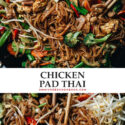Try out this vegetable-loaded takeout-style chicken pad thai if you prefer a rich and very rounded sauce without any pungent fish sauce. The chewy noodles, juicy chicken pieces and colorful crisp vegetables are cooked in a tangy sweet sauce that is well balanced. It satisfies your takeout cravings and keeps your dinner extra healthy. {Gluten-Free adaptable, Vegan / Vegetarian-Adaptable}
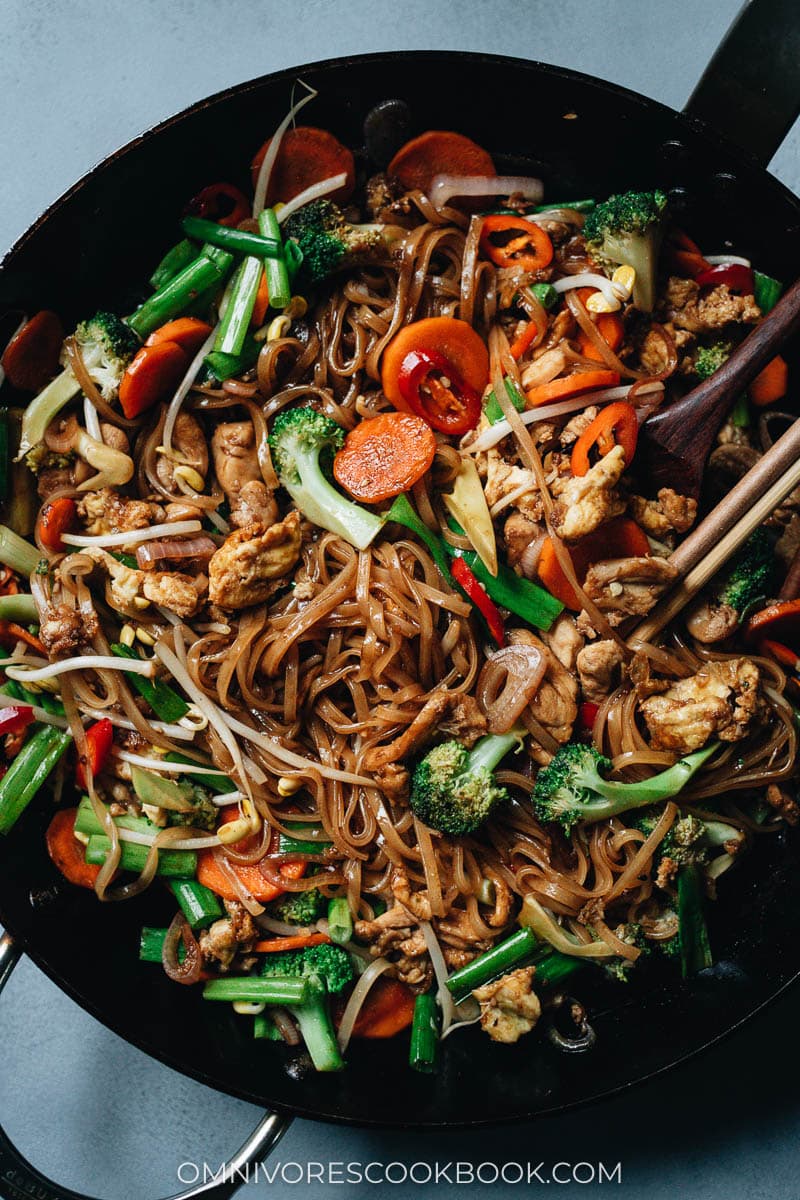
Growing up in China, I didn’t get exposed to much authentic Thai food because there were limited options available. My first encounter with pad thai was in Chicago back in 2014. I was visiting Thomas (boyfriend at the time, now husband) during the dead of winter and I was craving some hot soup. So, he ordered some tom kha gai and pad thai for me. I later learned that those were Americanized versions of the dishes, but I really enjoyed them at the time.
I would go on to try many great authentic-tasting Thai dishes after moving to New York City, amazed by their rich flavors and textures. But when I cook my favorite Thai dishes at home, such as chicken pad thai, I prefer to make the sauce slightly milder and add some extra vegetables.
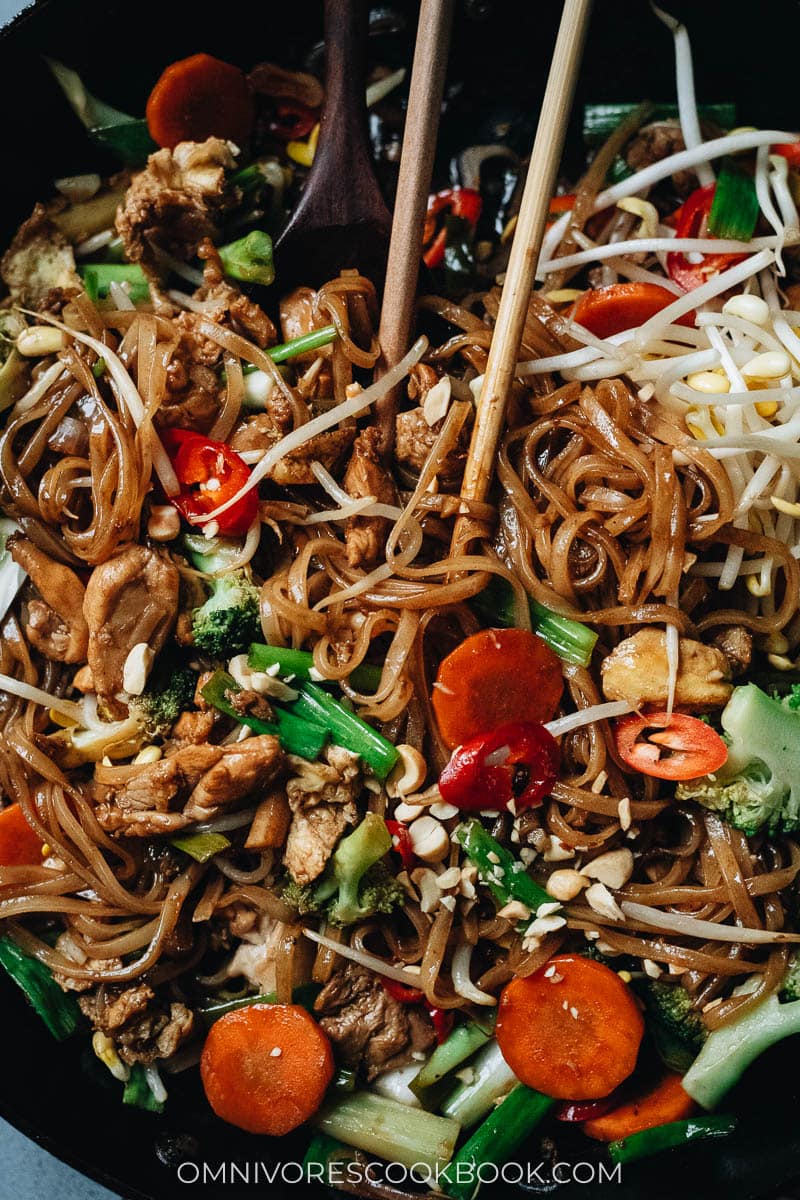
Why this recipe
If you like takeout-style Thai food, the fish sauce in the authentic pad thai might taste too pungent for you. That’s why I developed this chicken pad thai sauce that uses oyster sauce and soy sauce to replace the fish sauce. This combination:
- Adds a rich seafood-y and savory umami to the dish without the pungent fish sauce note.
- Consists of ingredients you probably already have in your pantry if you’ve been cooking Chinese food from my blog.
- You can easily change this recipe to a vegan or vegetarian version by using vegetarian oyster sauce to replace the regular oyster sauce.
I also added more vegetables – carrots, broccoli, and pepper. Not only do they add beautiful color to the dish, but they also add amazing texture and flavor. So you will have a one-pot dinner that is balanced and nutritious without needing to make extra side dishes.
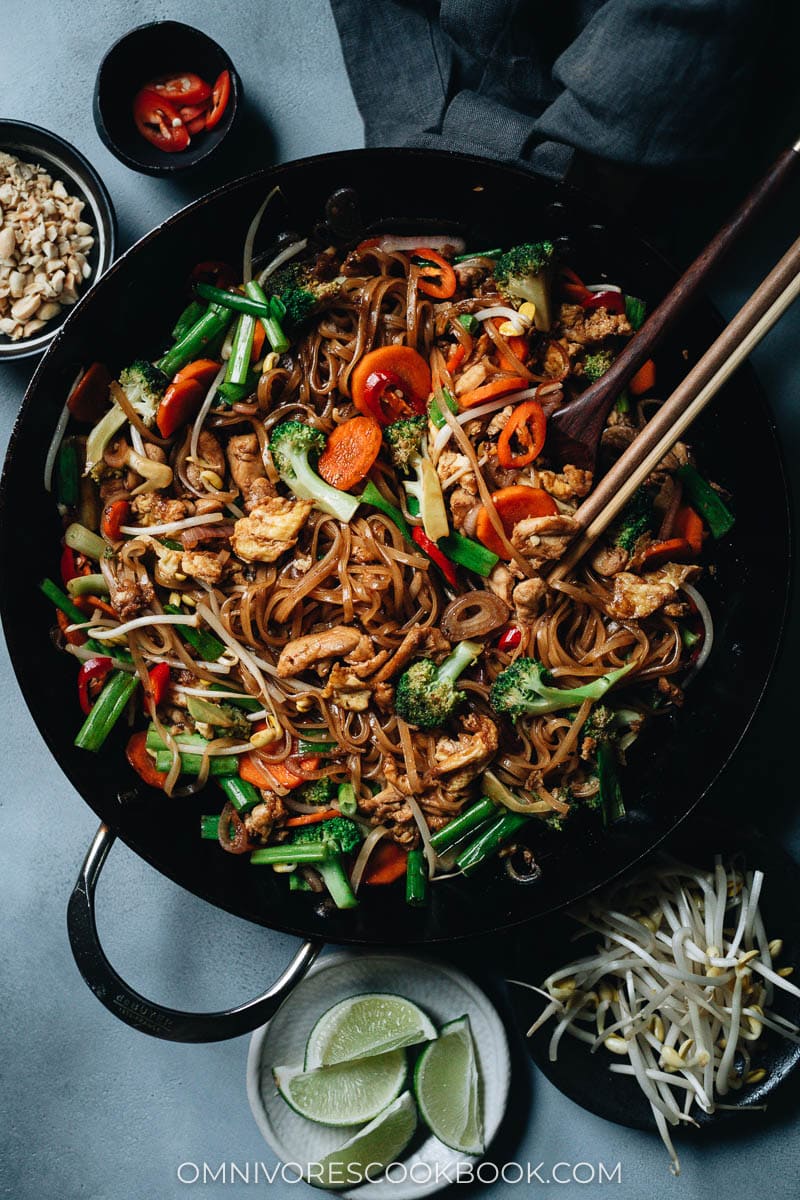
Ingredients
The noodles
Chicken pad thai uses the narrow dried rice noodles that are about 1/4” (4 cm)-wide. These days you can easily find them in many grocery stores in their ethnic / Asian aisle. And of course, you can find them in most Asian markets.
Some of the most common brands are Thai Kitchen, A Taste of Thai, and Erawan Brand (the one with the three-elephant logo). They all yield really good results if you soak them properly.
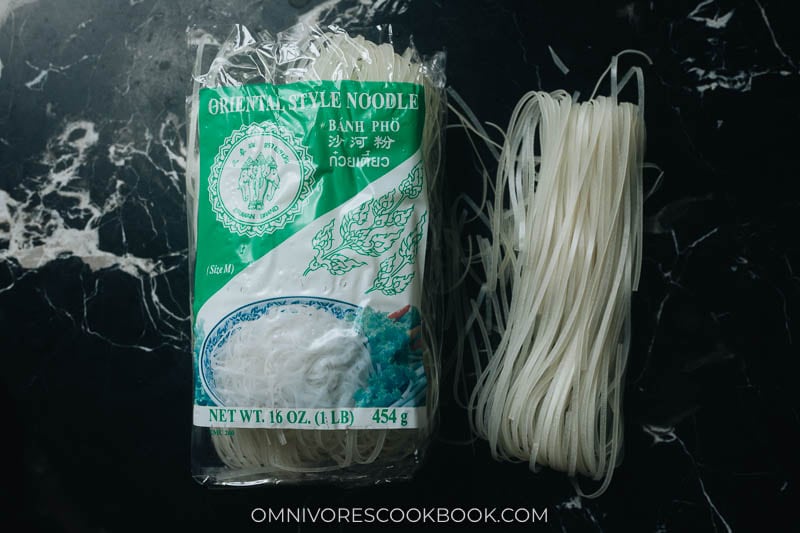
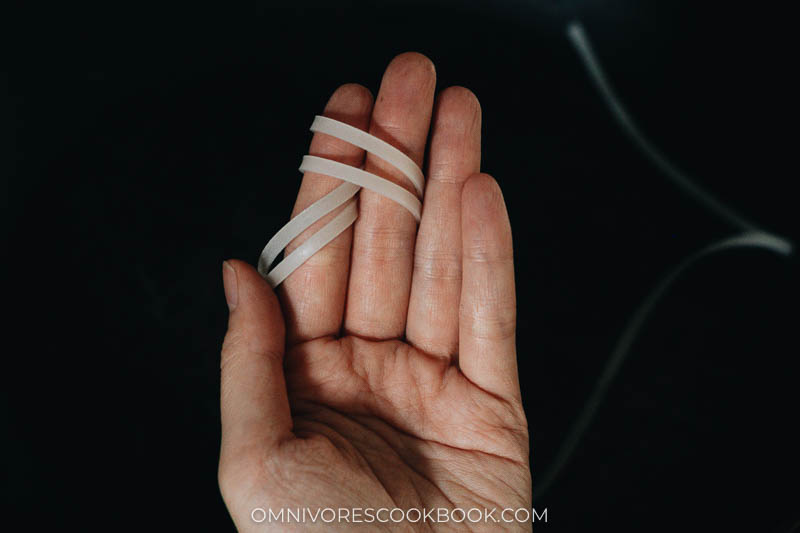
Key ingredient – tamarind paste
Tamarind paste is the crucial ingredient to use, so your chicken pad thai will not taste like it’s made with a ketchup sauce (many takeout places do that!). Even though I’m sharing the takeout version here, I still think you should stay away from ketchup if you can 🙂
Tamarind paste / puree has a dark color, a thick consistency like honey, and a tart, fruity taste. It is made from tamarind pods. It’s a common ingredient in Southeast Asian and Indian cooking to add a sour fruitiness to a dish.
Because tamarind paste has such a vibrant and complex flavor, you only need to add some sugar and oyster sauce to make a great pad thai sauce!
These days you can easily find it in a grocery store’s Asian / ethnic aisle. You can also find it online or in many Asian grocery stores.
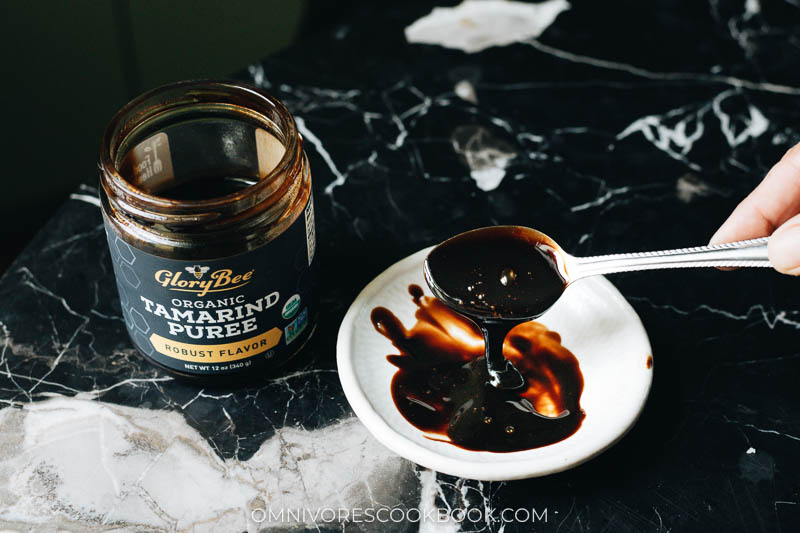
Prep work
Once you’ve done the prep, your table should have everything ready to go. Because when you start the stir fry, it moves super fast and you won’t have time to chop or prepare a missing ingredient.
PS. I totally forgot to add the soaked rice noodles into this photo (Ha!). They should be soaked and drained, then placed near the rest of the ingredients.
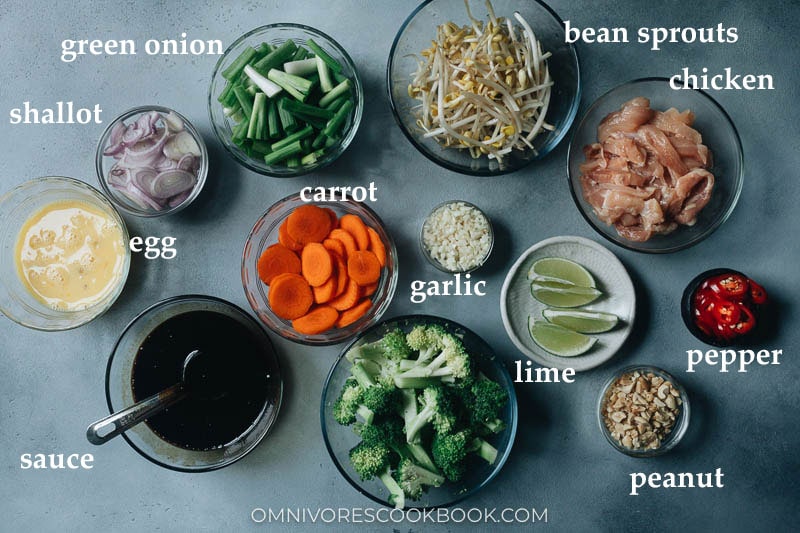
How to make vegan / vegetarian pad thai
I shared a vegan pad thai recipe in the past. That recipe is on the complicated end of the spectrum because I tried to use chickpea flour to make scrambled eggs to mimic the authentic pad thai texture.
If you want to make a quick and delicious vegetarian pad thai dish, simply use half a block of tofu to replace the chicken. Pan fry the tofu until golden brown on both sides.
If you want to make this dish vegan, use the tofu instead of chicken and skip the eggs. If you want to add texture to the vegan pad thai, try using some deep-fried tofu to replace tofu for a more dynamic texture.
Chicken pad thai cooking process
To get every ingredient cooked to the perfect doneness, it’s important to cook some of them separately and add back later.
- Steam the broccoli using your frying pan with a bit of water
- Pan fry the chicken
- Scramble the eggs
- Cook the aromatics and carrots
- Toss the noodles with sauce
- Add back the cooked chicken, eggs, and broccoli. Toss briefly
- Add the bean sprouts, green onions, and pepper
- Garnish with lime and extra bean sprouts and serve!
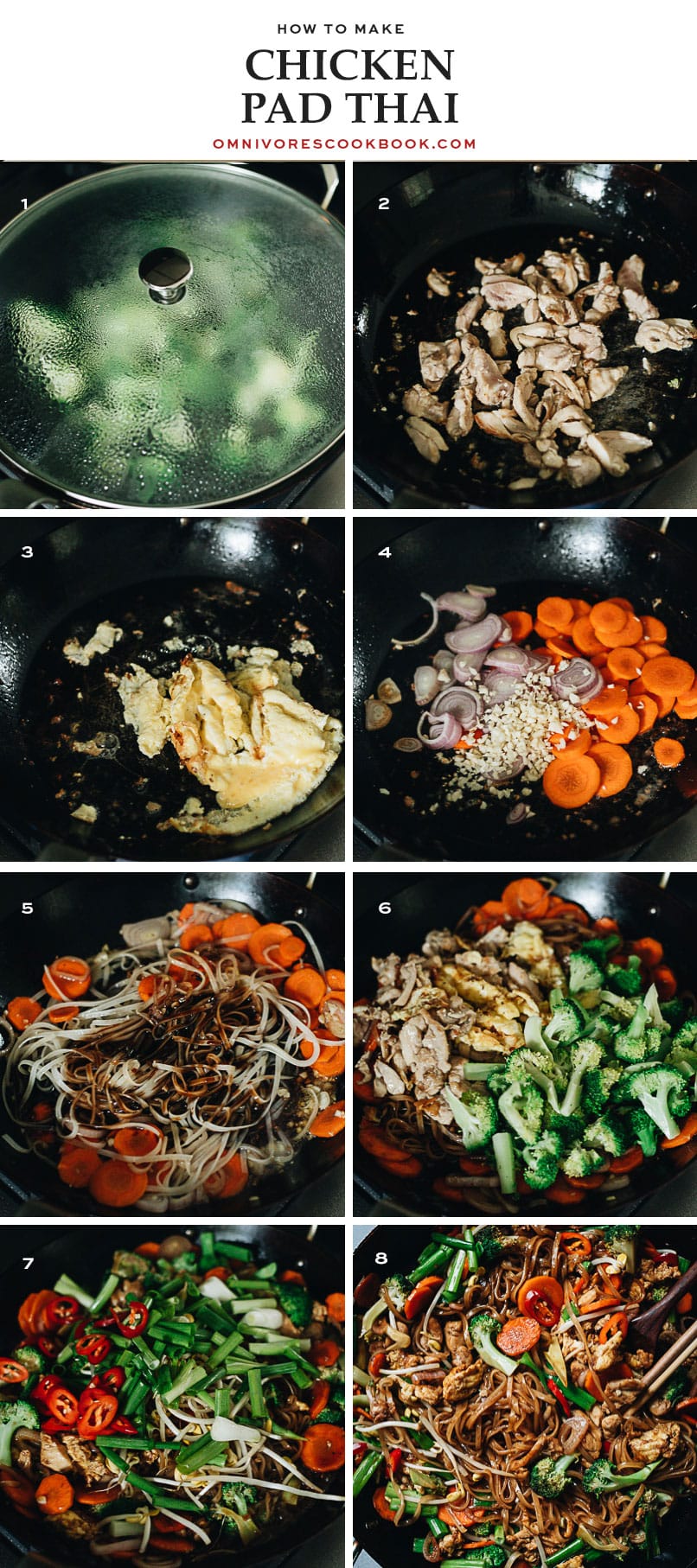
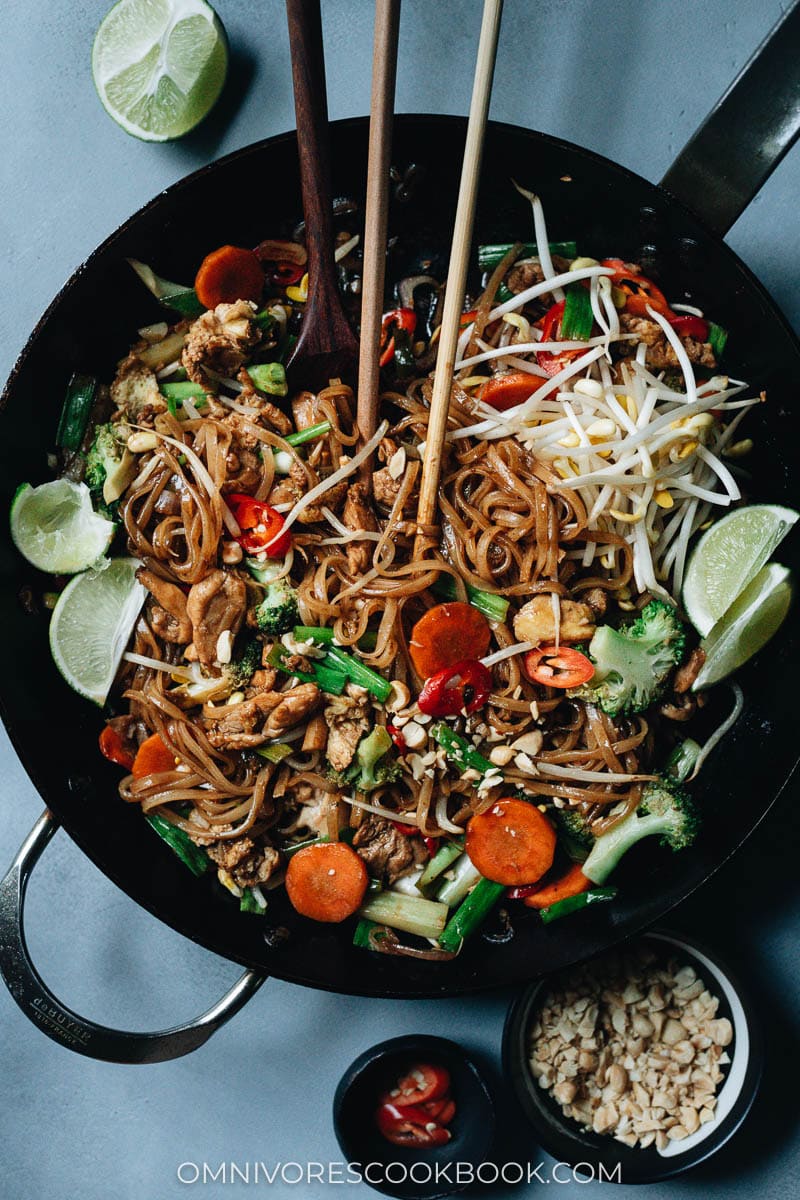
Afterthought
Cooking chicken pad thai at home is quick and easy! Once you have the key ingredients, you can easily get the rest of the ingredients at a regular grocery store. If you enjoy the dish, stock up on tamarind paste and rice noodles because they will keep for a long time if stored properly. Also, do feel free to replace the veggies according to your preference and have fun with the cooking!

Chicken Pad Thai (Takeout-Style)
Ingredients
- 4 oz (115 g) dried rice noodles , about 1/4” (5 cm)-wide
Chicken
- 8 oz (225 g) chicken breast , sliced thinly against the grain (or thigh)
- 1 teaspoon soy sauce
Sauce
- 3 tablespoons brown sugar (or palm sugar)
- 2 tablespoons tamarind puree (or tamarind paste)
- 2 tablespoons oyster sauce (or vegetarian oyster sauce) (*Footnote 1)
- 2 tablespoons soy sauce (*Footnote 1)
Stir Fry
- 1/2 head broccoli , cut into small bite-size florets
- 4 tablespoons peanut oil (or vegetable oil)
- 2 eggs , beaten
- 4 cloves garlic , minced
- 1 shallot , sliced
- 1/2 carrot , sliced
- 5 green onions , sliced into 1” (2.5 cm) pieces
- 1 long red pepper , sliced (or bird eye pepper if prefer a spicier dish)
- 1 1/2 cup mung bean sprouts , and extra for garnish
- 3 tablespoons peanuts , coarsely chopped
- 1 lime , sliced into wedges for garnish
Instructions
- For the noodles: Fully submerge the noodles in room temperature water for 30 to 40 minutes, until they are soft enough to wrap around your fingers without breaking apart, but not quite soft enough that you can bite into them. Drain and set aside.
- For the chicken: combine the chicken pieces and soy sauce in a medium-sized bowl. Mix with your hands until the chicken is evenly coated. Let marinate while preparing the other ingredients. (*Footnote 2)
- For the sauce: Combine the sauce ingredients and mix until the sugar is fully dissolved.
- To cook: Add 1/4 cup water to a large skillet and heat over medium-high heat until simmering. Add the broccoli florets and cover. Steam for 40 seconds to 1 minute, until al dente. Transfer the broccoli to a plate. Wipe the pan clean with paper towels.
- Add 1 tablespoon of oil to the same skillet. Add the chicken pieces with as little overlapping as possible. Cook without moving until the bottom turns golden brown. Turn to the other side, for 30 seconds or so, until the bottom just turns golden. Transfer to a plate and set aside.
- Add 1 tablespoon of oil and pour in the beaten eggs. Let cook without moving until the bottom sets, then start to scramble lightly, until the eggs are almost cooked. Transfer the eggs to the plate with the chicken
- Add the remaining 2 tablespoons of oil, the garlic, shallots, and carrot into the same pan. Cook and stir for 1 minute to release the fragrance.
- Add the noodles. Stir a few times to mix everything together. Pour in the sauce. Cook and stir until the sauce is mostly absorbed.
- Add back the cooked chicken, eggs, and broccoli. Stir a few times to mix well.
- Add the green onion, pepper, and bean sprouts. Toss for another 30 seconds, until the vegetables are just wilted. Carefully taste a noodle. If it’s still too tough, add a splash of water and stir to mix well. Cook for another 1 to 2 minutes until the noodles reach the texture you prefer.
- Garnish with the remaining bean sprouts, peanuts, and some wedges of lime. Serve hot as a main dish.
Notes
- If you prefer a more authentic taste, use 2 tablespoons of fish sauce to replace the 2 tablespoons of oyster sauce and 2 tablespoons of soy sauce. I personally prefer the “takeout style” rounded sauce that is less fishy but still very rich. If you want to make this dish vegan or vegetarian, use vegetarian oyster sauce with tofu and you’ll get a great dish as well.
- If you use chicken breast, you can also add 1 teaspoon cornstarch to the mix, so the chicken will stay more tender without getting overcooked. Chicken thigh is less likely to overcook so you can skip the starch with the thigh.













